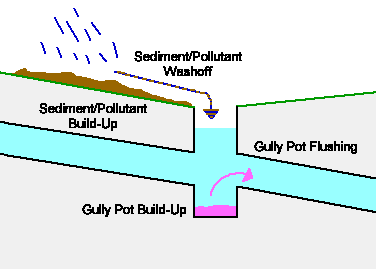Surface Pollutant Model
This model calculates the buildup and washoff of pollutants on catchment surfaces and in gully pots.
The model treats sediments and attached pollutants separately from dissolved pollutants.
- Sediments, and any pollutants attached to sediments, build up on the catchment surface during dry weather periods. During a period of rainfall they are washed off the surface into the drainage system by surface runoff. This process is known as the Innovyze Washoff Model.
- Dissolved pollutants build up in gully pots between periods of rainfall. During a rainfall period, surface runoff entering the drainage system washes these dissolved pollutants into the network. This process is known as the Gully Pot Model.
These two processes are modelled completely independently by InfoWorks ICM. They do not interact in any way.
The diagram below illustrates the two processes involved in the surface pollutant model.

Surface Pollutant Model
Use the Surface Pollutant Editor to define the subcatchment characteristics required by the Surface Pollutant model.
These characteristics are defined in an object called a Pollution Index.
Innovyze Washoff Model
The rate at which eroded sediment runs off into the system is calculated using your chosen hydraulic runoff model.
The washoff of sediment (always Sediment Fraction 1) from the surface and the resulting inflow of each attached pollutant based on their potency factors are calculated. The washoff is taken from the effective impermeability.
No dissolved pollutant enters the system from the washoff model; only sediment and attached pollutants are introduced to the sewer network using the washoff model.
Gully Pot Model
The calculations for the gully pot model use the runoff from Runoff Surface 1 defined in the Land Use Definition. By convention, Runoff Surface 1 is the road surface.
The runoff is calculated by the hydraulic engine, using the runoff model you selected for hydraulic calculations.
No sediment deposition or erosion is modelled by the gully pot model. Only dissolved pollutants are introduced to the sewer network using the gully pot model.
Pollution Index
The Pollution Index is the water quality equivalent of a Runoff Surface:
- A Runoff Surface describes the hydraulic properties of an area of the catchment surface.
- A Pollution Index describes the water quality characteristics of an area of the catchment surface.
Runoff Surfaces and Pollution Indices are applied via a Land Use:
- For hydraulic runoff, you can divide the subcatchment into up to 12 areas by applying up to 12 Runoff Surfaces to the Land use.
- The Land Use has just one Pollution Index, defining the water quality parameters of the entire subcatchment.
See the Pollution Index topic for details.
Model process
The Surface Pollutant Model Process topic describes the operation of the Surface Pollutant Model as part of a simulation.
Further information
The calculation of buildup and washoff can be split into 4 main steps. To get more information on these steps, follow the links below:
- The build-up of surface sediment and pollutants prior to the current simulation is calculated (assuming you have allowed a build-up time).
- You can define initial surface sediment depths prior to a build-up period, or instead of allowing a build-up period in the Rainfall Event Editor.
- The build-up of pollutants in gully pots prior to the current simulation is calculated (assuming you have allowed a build-up time). The build-up is linear over time.
- Parameters used in the runoff and washoff calculations are initialised.
- The simulation is started and runoff and washoff calculations are made at every timestep:
- Build-up continues throughout the simulation.
- Surface erosion is related to rainfall intensity. The runoff calculations used for surface erosion use the runoff model selected for hydraulic calculation.
 Water Quality
Water Quality
